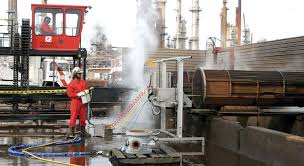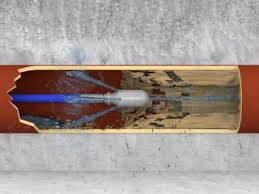Everything You Need to Know About Hydrojetting
Hydrojetting is a new plumbing strategy that plumbers all over the country are beginning to adopt to tackle more severe clogs that cannot be easily remedied with plungers. This technology is a significant addition to the plumbing industry and it is important to understand exactly how it works.
What is Hydrojetting and How Does it Work?
Hydrojetting is a process that uses pressurized water to clear pipes. Professionals pump the high-pressure water through your pipes and it clears the interior of any debris that has built up and caused a clogged or slower flow.
Previously, most plumbers would use a technique called rodding. Rodding is when you use a tool to create a hole through the debris in an effort to open up the flow more. Hydrojetting is significantly more thorough and effective in clearing build-up.
A plumber will identify the ideal area to pump the water and insert a hose that is connected to a large tank of water. Depending on the severity and nature of your clog, the plumber will choose a pressure level to use. Hydrojetting can shoot up to 20 gallons of water through your pipes each minute. Because most pipes angle downward from your home into the sewer system, the dislodged material that was blocking your pipe will flow down into the sewer system.
Hydrojetting can take care of a wide variety of different materials. It will clear grease, hair, food or soap residue, and even tree roots and mineral build-up.

Steps in the Hydro Jetting Process
Here’s what occurs when you schedule this service:
1. Your licensed plumber locates the plumbing system cleanout, which gives an easy access point to the piping throughout your home.
2. He or she uses a camera to inspect your plumbing pipes and drain prior to jetting. This step searches for damage within the system, such as cracked or crumbling pipes, which could be worsened by the process.
3. Your plumber inserts the jetting hose downstream into the plumbing lines. This durable hose attaches to a water tank that pressurizes water.
4. Your plumber adjusts the water pressure to appropriate levels for pipe conditions. Hydro jetting typically involves water pressure up to 35,000 psi.
5. Once the high-pressured water begins, the tool moves upstream through the plumbing lines as it scours the interior pipe walls.
6. The tool removes built-up debris from the inside of the pipe walls. Gravity pulls the debris down through the home plumbing system and safely flushes it out of the home.

What is Hydro Jetting Used For?
Hydro jetting is used to completely eliminate scale buildup and heavy root intrusion in main sewer lines, and heavy grease and scale buildup in kitchen lines. It is especially useful in commercial applications for restaurant lines due to excessive grease. When kitchen drain pipes get frequent use and have even minimal amounts of grease poured into them on a regular basis, they can quickly become full and close off the flow of water. Additionally, the unique plumbing method of hydro jetting will rotate the high-pressure water in the drain lines, scouring the inside of the pipe and restoring it to optimal condition.
Is Hydro Jetting Safe?
Hydro jetting, even at the highest PSI is safe for most kitchen and sewer drain lines. It is especially important that the licensed contractor performs a camera inspection prior to hydro jetting to determine the pipeline condition. If the pipe is deteriorating, has cracks or holes, or looks frail in places, hydro jetting may not be the best immediate option. Even regular snaking can break a drain line that is in poor condition. When hiring a drain specialist, make sure to choose a licensed, insured and bonded contractor to keep your property safe and protect the integrity of the lines as much as possible.

Hydro Jetting Procedure
Hydro jetting is done by inserting the specialized hose inside a cleanout. A cleanout is an opening in the plumbing system that gives plumbers access to the sewer pipes for cleaning and repairs. The hose is then activated to allow highly-pressurized water to wash away any dirt and debris found in the sewer pipes. The pressure of the water coming out from a hydro jet can reach up to 3,500 psi which makes it an ideal method in removing even the most stubborn dirt such as tree roots. Hydro jetters can clean several hundred feet of sewer pipe.
Hydro Jetting Vs. Snaking
Cleaning the main drain of your sewer line is something that many homeowners need to do on a regular basis. This type of maintenance prevents sewer backups, removes tree roots from the pipe and is a good way to keep tabs on the state of the sewer line.
There are two standard methods for cleaning the sewage line: hydro jetting and snaking. Both methods are a common service offered by plumbing and drain cleaning companies. Understanding the differences between hydro jetting and snaking can help homeowners pick the right method for their sewer.
The Hydro Jetting Method
Hydro jetting is achieved when a very forceful stream of water between 3,000 and 8,000 PSI is forced into the sewer line. This stream of water is strong enough to clear out any debris or clogs in its way, including tree roots, grease and hair.
Advantages of Hydro jetting:
Hydro jetting is extremely effective: High water pressure is highly effective for cleaning out clogged sewers and maintaining a clean sewer line. A strong enough jet of water can even remove tree roots.
Hydro jetting services are versatile: With a high enough PSI, water pressure is strong enough to clear commercial sewer lines as well as domestic lines.
Disadvantages of Hydro jetting:
Too much water pressure can damage some pipes: Sometimes hydro jetting works a little too well. Older, fragile pipes and damaged pipes may not be able to withstand the force from such a powerful stream of water. Luckily, hydro jetting is not a do-it-yourself activity. Plumbing companies that offer hydro jetting services know to inspect pipes and determine the strength of pipes before using hydro jetting equipment.
The Snaking Method
Snaking is done with an auger. An auger looks like a long steel cable with a cork-screw like coil at one end. When the auger is inserted into the sewer line, the coil at the end pierces obstructions it encounters and clears a path through the pipe.
Advantages of Snaking:
Snaking is historically effective: It is a time-tested, proven method for clearing basic clogs in sewer drains.
It won’t damage fragile pipes: Snaking is relatively gentle and poses no threat to older pipes.
Disadvantages of Snaking:
Snaking only clears a path as wide as the tip of the auger: While snaking is an effective method for clearing basic clogs and increasing drainage speeds in slow sewer drains, snaking is only a temporary fix for many problems that homeowners experience with their sewer lines.